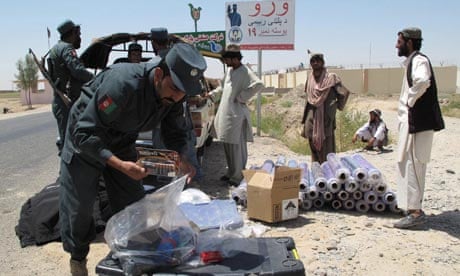Two Afghan policemen have shot dead a senior commander and eight other officers, the latest in a string of attacks by rogue security forces that are poisoning efforts to build up the police and army as foreign troops head home.
The attack in south-western Nimruz province near the Iranian border on Saturday was the fifth in less than a week to involve men in uniform turning on their comrades or foreign trainers.
The attackers were local men who had only signed up for the police three months ago, said Shakila Hakimi, head of the Nimruz provincial council. In an added twist, the pair targeted the man who had vouched for their trustworthiness, the provincial head of criminal investigations, Abdul Hadi Azizi, said.
Mohammad Eesa was based in the provincial capital, but was making a brief visit to the troubled Delaram district to discuss the security situation, he said. "These two man came yesterday because they knew Eesa and through him had been introduced to the district police chief and got their weapons and uniform," Azizi said by phone, after visiting the site of the shooting.
The men opened fire in the yard of the district police chief's office, killing Eesa and eight others, and wounding another man before they were themselves shot, he added. "This was a very sophisticated effort by the insurgents," Azizi said. "Eesa was a good guy, very honest. He was cheated by these two guys as he didn't know they had a connection with the Taliban."
The insurgent group claimed credit for the attack, which came just a day after policemen shot dead six US soldiers in neighbouring Helmand province.
It was the bloodiest single day for foreign troops in the province since six British soldiers were killed by a roadside bomb in early March, and a grim reminder of the growing threat foreign forces face not just from the Taliban but also from their supposed allies.
Three US Marine Corps special operations troops were shot dead early on Friday in Sangin district, a northern corner of the province that has seen heavy fighting. The killers were an Afghan police commander and some of his men, who had invited the US officers to join them for a meal and to discuss security.
In the evening, an Afghan policeman shot dead a further three US soldiers as they exercised on a joint base about 40 miles south-west of the provincial capital.
On Tuesday, two Afghan soldiers killed a US soldier and injured two others in eastern Paktia province, and on Thursday two other Afghan soldiers opened fire on a group outside another base in the east, although the only person killed was one of the gunmen.
So far this year 37 foreign soldiers and military contractors have been killed in 27 such attacks, far more than in 2011. They have become such a commonplace threat that foreign units working with Afghan forces are often watched by armed "guardian angels" from their own ranks.
In a sign of growing concern, President Hamid Karzai issued a rare condemnation of the deaths of foreign soldiers, and ordered an investigation into shootings in Helmand and Paktia. "The enemy … does not want to see Afghanistan have a strong security force, targets military trainers," Karzai said in a statement that described the gunmen as "terrorists in Afghan security uniform".
Nato commanders argue that the attackers account for a tiny portion of security forces, now more than 300,000 strong, and say many are driven by personal grudges rather than loyalty to the Taliban or other insurgent groups.
But the shootings are disproportionately damaging to morale, and in some ways the attacks on Afghans from within their own forces are more worrying than the attacks on foreign forces.
The Nato trainers will eventually head home, leaving the Afghan police and army to fight a hardened insurgency, a challenge that will be made much tougher by mistrust in their own ranks.
